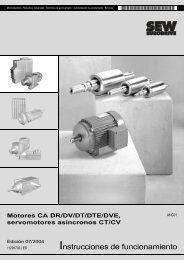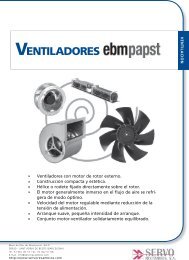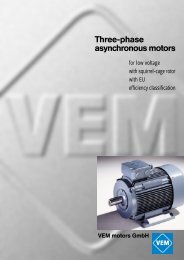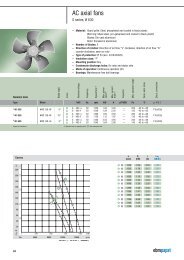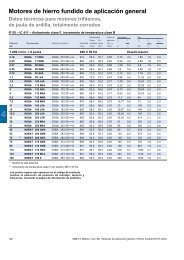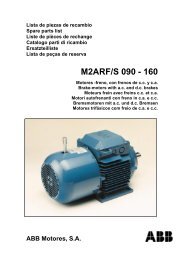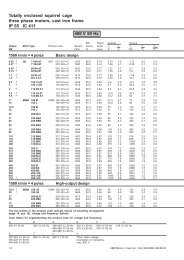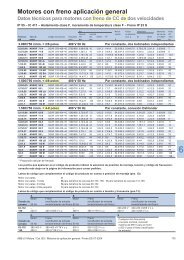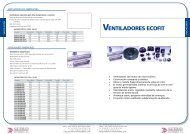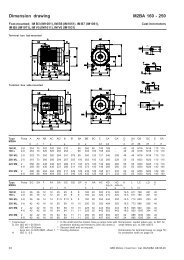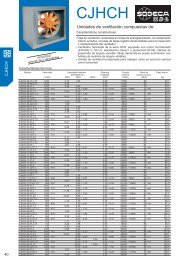Motor Starting Relay - Servorecambios
Motor Starting Relay - Servorecambios
Motor Starting Relay - Servorecambios
Create successful ePaper yourself
Turn your PDF publications into a flip-book with our unique Google optimized e-Paper software.
I N N O V A T I V E S O L U T I O N S I N S E N S O R S A N D C O N T R O L S<br />
Product Bulletin<br />
2CR<br />
<strong>Motor</strong> <strong>Starting</strong> <strong>Relay</strong><br />
All position, current-type<br />
Designed for all position operation,<br />
the Klixon 2CR is a current-type<br />
motor starting relay which can be<br />
used on both split-phase and capacitor-start<br />
motors. It has broad application<br />
versatility which includes<br />
business and computing machines,<br />
power tools, food machinery,<br />
portable appliances and dishwashers.<br />
The compact 2CR can be mounted<br />
and operated in any position, either<br />
in the motor, or at a convenient location<br />
away from the motor. This<br />
allows motor size to be reduced<br />
since a space-consuming centrifugal<br />
switch is not required.<br />
Construction<br />
The 2CR relay utilizes a rotating balanced<br />
armature which is held normally<br />
open by a biasing spring.<br />
Rotation of the armature, which carries<br />
the movable contact arm, is<br />
caused by the magnetic field produced<br />
by motor current in the relay<br />
coil. Large “make” and “break” contact<br />
forces are developed by using a<br />
large iron cross-section in the magnetic<br />
circuit and a high number of<br />
ampere-turns. A beryllium copper<br />
contact arm of high conductivity<br />
assures excellent current carrying<br />
capability. Stable calibration values<br />
are achieved by biasing the armature<br />
with a stainless steel torsion<br />
spring having a large number of<br />
turns and low spring rate. All parts<br />
are fully enclosed in a rugged phenolic<br />
case.<br />
Operation<br />
The 2CR relay coil is in series with<br />
the main winding of the motor and<br />
the normally open contacts are in<br />
series with the start winding. When<br />
voltage is applied to the motor, the<br />
in-rush currentof the main winding<br />
through the relay coil creates a magnetic<br />
force which instantly rotates<br />
the armature. This action closes the<br />
relay contacts and energizes the<br />
motor start winding. As motor speed<br />
increases, the current in the main<br />
winding and relay coil decreases to<br />
a point where the armature biasing<br />
spring force is greater than the<br />
decreasing magnetic force and the<br />
armature rotates back to its original<br />
open position. This opens the relay<br />
contacts and disconnects the start<br />
winding.<br />
Mounting and terminals<br />
Standard relays are furnished with<br />
either type A or B mounting brackets<br />
as shown below. Quick-connect terminals<br />
are used on standard relays.<br />
Screw and solder type terminals are<br />
also available.<br />
2CR3<br />
Key Benefits<br />
Open view of 2CR relay<br />
• All position performance - balanced<br />
armature allows mounting and operation<br />
in any position<br />
• Wide range of pick-up and drop-out ratings<br />
• Small size for installation in compact<br />
equipment<br />
• Clean, positive contact “breaks” and “makes”<br />
with wiping action - high contact forces<br />
developed by magnetic circuit with more<br />
iron and copper<br />
• Stable operating values - continuously open<br />
magnetic circuit eliminates residual magnetism<br />
• Rugged, all welded construction, fully<br />
enclosed in phenolic case<br />
2CR4<br />
(All brackets are 1,57 mm thick. Mounting hole 3,94 mm dia.
Pick-up and Drop-out ratings<br />
Ratings indicate maximum pick-up and minimum dropout<br />
current limits. Pick-up is the current through the<br />
relay coil required to close the relay contacts. Dropout<br />
is the current through the relay coil at which the<br />
contacts open. A production relay of a given rating will<br />
have a pick-up and drop-out current within the rating<br />
limits.<br />
Sample code<br />
Schematic diagrams<br />
Important Notice: The products and services of Texas Instruments and its subsidiaries described herein are sold subject to TI’s standard<br />
terms and conditions of sale. Customers are advised to obtain the most current and complete information about TI products and services<br />
before placing orders. TI assumes no liability for applications assistance, customer’s applications or product designs, software<br />
performance, or infringement of patents. The publication of information regarding any other company’s products or services does not<br />
constitute TI’s approval, warranty or endorsement thereof.<br />
© 2003 Texas Instruments Printed in Holland 10/03 PB10



